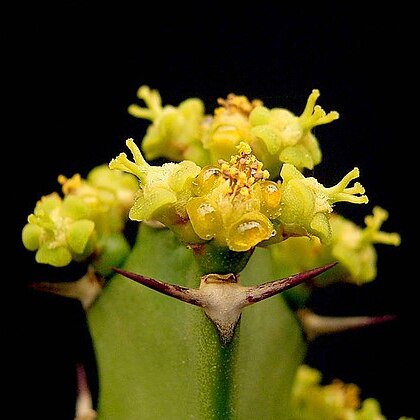Monoecious, spiny, much-branched tree, 5-16 m, with cylindrical trunk and ascending branches bearing an apical rosette of ascending (2)3(4)-angled, green, deciduous branchlets 12-20 mm diam., spines 0.5-6.0 mm long. Leaves minute, triangular, deciduous. Cyathia 4-5 mm diam., glands entire, yellow-green.
Spiny, succulent tree, up to 10 m high. Main trunk cylindric with 1 to several erectly ascending stem-like branches. Secondary branches and branchlets up to 15 mm thick, slender and not at all constricted into segments, acutely 3-or 4-angled. Flowers yellow.
Trunk with several stout, ascending branches, rebranching with ultimate branchlets in clustered whorls at the apices; secondary branches densely rebranching, deeply 2–4-angled, 1.2–2 cm wide; angles sinuate with tubercles 8–30 mm apart along the margins.
Cyathia 2.5 × 4–5 mm, with cup-shaped involucres; glands transversely oblong, 1.5–3.5 mm wide, touching, yellowish-green; lobes subquadrate, dentate.
Female flower: perianth 3-lobed, with lobes 1 mm long; styles 1.5 mm long, joined at the base, with spreading, shortly bifid tips.
Spine shields quite separate, 2–7 × 2 mm, obovate; spines to 0.5–6 mm long; prickles vestigial.
Capsule deeply lobed, c. 8 mm in diameter, exserted on a curved pedicel to 8 mm long.
Cymes solitary, simple, subsessile; bracts 1 × 1.5 mm, scale-like.
Male flowers: bracteoles c. 2.5 mm long; stamens to c. 4 mm long.
Seeds c. 2.5 mm in diameter, subglobose, brown, smooth.
Leaves 1 × 1 mm, scale-like, deltoid, deciduous.
Succulent, spiny tree to 10–16 m high.


